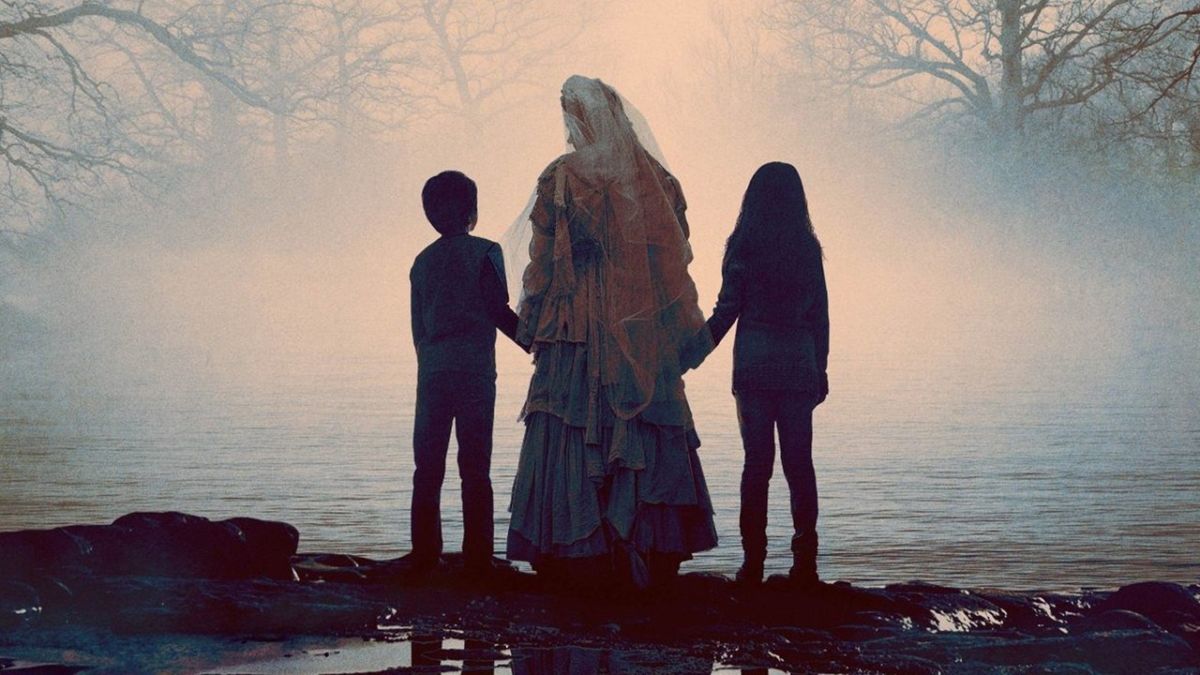La Llorona, or “The Weeping Woman”, is a Mexican folktale, one that nearly every person of Mexican descent is familiar with (although variations of the tale exist in nearly every Spanish and Latino country). La Llorona is the ghost of a woman who drowned her own children before killing herself, and she now haunts the world searching for other children to punish, often for misbehaving. It’s a somewhat sacred story that parents use to lovingly traumatize their kids into acting right, and it’s one that The Curse of La Llorona, disappointingly, both sullies and whitewashes.
Anna Tate-Garcia (Linda Cardellini) is a widow and mother to two children: her son, Chris (Roman Christou) and her daughter, Sam (Jaynee-Lynne Kinchen). She’s also a social worker, and when the behavior of one of her cases raises alarms, she’s sent out to investigate. Patricia Velasquez (Patricia Alvarez) has locked her two young boys in a closet, and is refusing to allow anyone to let them out. She claims it’s for their own safety, but Anna releases them anyway, much to Patricia’s chagrin. Anna soon realizes that this was a mistake; Patricia was attempting to protect her sons from the dreaded La Llorona, and now the spirit has moved on to Anna’s family, filling their lives with terror.
Despite the legend being distinctly and exclusively Latino, The Curse of La Llorona chooses to focus its story on a white woman, one that has no prior familiarity with the folktale (the Spanish-speaking characters in the film, of course, do). Many in the Latino community have been eager and excited to see such a beloved (oddly enough, you could call it that) story from their childhoods shown on the big screen, but having the lead be white misses out on the easy opportunity for representation. That’s not to say that there’s none: Tony Amendola briefly reprises his role as Father Perez from the Annabelle films (La Llorona is the most recent addition to the Conjuring universe), Marisol Ramirez does a terrifying job of portraying the titular ghost, and Raymond Cruz shines as an unorthodox former priest who helps the family out.
There’s also Patricia, but the way her character is handled only furthers the problematic nature of how the film whitewashes itself. Patricia is often bathed in a menacing light, her hair messy, and her face contorted into a snarl. She serves as a somewhat secondary antagonist for Anna, and it’s troubling to see the film’s only Spanish-speaking woman shown mostly in a villainous way. Blame for these issues could rest on the creative team behind the movie – writers Mikki Daughtry and Tobias Iaconis, as well as director Michael Chaves, have no cultural connection to the folklore the film is based on whatsoever. Perhaps it would’ve helped to bring on an additional writer, one of Mexican heritage.
READ NEXT: The Best Modern Horror Movies
Social and representation issues aside, how does La Llorona stack up to other horror films, and the rest of the interconnected Conjuring universe? Not all that well, sadly. Still, Chaves and cinematographer Michael Burgess do a good job of creating a creepy atmosphere and building up the scares, allowing the camera to walk freely with the characters, showing the audience exactly what they want, or don’t want, them to see. The excellent use of darkness and shadows adds to the creep factor, teasing only glimpses of the demon until the time is right. It’s all mostly jump scares, which might often feel cheap, especially in a post-Hereditary film landscape, but the Conjuring-verse has always seemed to earn theirs by properly building up the tension surrounding the jumps.
Unfortunately, there’s little to connect with or care much about in La Llorona’s narrative. It’s horror without any substance, similar to last year’s The Nun, and it’s disappointing when the first two Conjuring films were as thematically rich as they were terrifying. There’s multiple threads in the story that could’ve been fleshed out, but the film never chooses to do so. Patricia blames Anna for her misfortunes, but we never see Anna wrestle with any sort of feelings of guilt in relation to this. Anna being a widow has little to no impact, other than a touching scene where she watches her son pretend to be a policeman (as his dad was). You might think that this is to show that Chris wants to brave like his father, and he’ll get the chance to prove himself later in the movie, but it never happens.
Anna is a workaholic at the start of the film to the point where her coworkers tell her she needs to spend more time at home with her kids rather than at the office, something that you’d assume will play into the narrative, but it doesn’t. Work never gets in the way of Anna being home to protect her children from the ghost haunting their house. There’s a moment at the end involving the necklace that La Llorona wears, but it’s unclear what it means, and it’s never explained. There’s just not enough there, and barely any personality in any of the characters save for Raymond Cruz.
The Curse of La Llorona has good and suspenseful scares but little else. It feels hollow due to a lack of interesting themes and emotion, and it shows no interest in honoring the legend it’s based on. In relation to the rest of the Conjuring universe, it feels largely disconnected (besides a small cameo) and its ending feels too definite to warrant a return to this particular story. It’s a massively wasted chance at something that could’ve been really special, and that’s the only thing here worth weeping over.
Some of the coverage you find on Cultured Vultures contains affiliate links, which provide us with small commissions based on purchases made from visiting our site.

